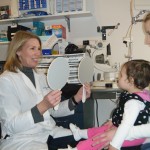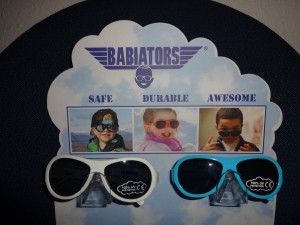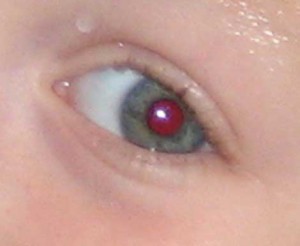A common complaint I hear is “my eyes burn and water.” Meibomian Gland Dysfunction is a common, chronic condition and is usually the cause of the discomfort. MGD occurs when the opening to the meibomian gland is plugged. The openings to the glands are at the edge of the eyelid margins, near the base of the eyelashes. The blockage can be caused by make-up, lotions, and sunscreens that plug the opening. Other factors are usually involved too. For example, skin conditions such as acne rosacea are a common cause of MGD. Age, sex, hormonal disturbances, allergies and certain medications negatively affect the glands too.
The treatment depends on the severity of the condition. Hot compresses and eyelid hygiene is always recommended. Dietary modifications, inclusion of omega-3 fatty acids and hydration are beneficial. For more advanced cases, topical and/or oral medications may be required to control MGD.
If left untreated, the glands will thicken and scar causing chronic dry eye signs and symptoms and more discomfort.
Blog
Westside Optometry Expands Services
I’m going to crow a little here. The California State Board of Optometry notified me that I’m officially licensed to provide glaucoma care. This is an endeavor I started 10 years ago with  course work at UC Berkeley. I put it on hold because the state requirements were insurmountable. Laws changed and last January I made the decision to finish what I started with more coursework through UC Berkeley. After hours of online cases and tests (how things changed in 10 years) and two days of grand rounds at the School of Optometry I had completed all the education and patient cases.
course work at UC Berkeley. I put it on hold because the state requirements were insurmountable. Laws changed and last January I made the decision to finish what I started with more coursework through UC Berkeley. After hours of online cases and tests (how things changed in 10 years) and two days of grand rounds at the School of Optometry I had completed all the education and patient cases.
Most of my patients won’t experience any difference in their care. But for those who I’ve been observing more closely for suspicious glaucoma findings, I won’t have to refer you to someone else as I can now treat the disease.
First Exam for Infants
The first year of life is one of the most critical stages in childhood development. From the moment a baby opens it’s eyes, newborns undergo dramatic physical and mental changes.
During the first 12 months, infants should have a comprehensive vision assessment to determine proper development and identify any health problems. Early detection and treatment of potential problems are vital to a child’s development . For information about how Dr. Griffith examines babies click here.
One in every 10 children is at risk from undiagnosed eye and vision problems, yet only 13 percent of mothers with children younger than 2 years of age said they had taken their babies to see an eye doctor for an examination. Early intervention is critical to successful and cost-effective treatment. Unfortunately, during the course of their young lives, most children probably never have an eye examination.
Please take advantage of the InfantSee program. Dr. Griffith fully supports this American Optometric Association program designed to examine all infants between 6-12 months. There is no cost or qualification required. Call the office (707)762-8643, and ask for an InfantSee exam for your infant.
Fall Eyewear Event
Westside Optometry is proud to host the Fall Eyewear Spectacular.
Saturday, September 7
between 10 and 2
First you’ll see the Maui Jim tent in the parking lot. You can try on every style in every color. Our knowledgeable company representative can answer all your questions on the different lenses and features.
Inside we will have several of our favorite designers including FYSH, William Morris, Kliik, Evatik, Lisa Loeb and some new children’s frames. Call ahead to schedule your eye exam, or come on by for a snack and fun. 
Glasses before Medications
High, undiagnosed hyperopia (far-sightedness) can cause children to display symptoms similar to ADD/ADHD, including difficulty concentrating and problems with reading. Before any child is prescribed medication for ADD or ADHD, a thorough eye examination is vital. Vision Screenings done at the pediatricians or by a school nurse often miss hyperopia. Most children with hyperopia can see in the distance fine, but have difficulty focusing on objects close to them. It’s scary to think about how many kids are taking medications just because they’re farsighted.
Back-to-School
Computers and smartboards are common in today’s classrooms. As electronic devices transition between home and school, it’s clear that the use of these technologies is evolving from a trend to a necessity, even among the youngest students.
According to a study by the American Optometric Association (AOA), 41% of children have their own smartphone or tablet and 32 percent use both eBooks and textbooks at school. Additionally, 66 percent of children use a computer or tablet to do homework or study. With the consistent use of electronic devices throughout the day and evening, children of all ages can face a number of visual challenges.
Ongoing use of electronic devices won’t damage vision, but regular, lengthy use of technology at school or for homework can lead to a temporary vision condition called computer vision syndrome (CVS). Symptoms of CVS can include eye strain, headaches, fatigue, burning or tired eyes, loss of focus, blurred vision, double vision or head and neck pain. The doctors at Westside Optometry recommend that students rest their eyes by following the 20-20-20 rule. When using electronic devices or doing near work, take a 20-second break, every 20 minutes and view something 20 feet away.
One in four children have an undiagnosed vision problem simply because they may not recognize that their eyesight isn’t optimal or is changing. Comprehensive eye exams are one of the most important investments a parent can make to help maximize their child’s education and contribute to overall health and well-being, especially since some vision problems may not have warning signs. Unfortunately, parents often assume that if a child passes a school screening, their vision is fine.
Below are some symptoms that can indicate a child has a vision problem:
- Squints while reading or watching television
- Turns or tilts head or covers an eye
- Consistently performs below potential or struggles to complete homework
- Has behavioral problems
Call Westside Optometry (707)762-8643 to schedule an eye exam for your child.
Back-to-School Eyewear
It’s that time again, new backpack, new shoes and don’t forget about updated glasses. Westside Optometry is featuring children’s eyewear for August. 
For more information and pictures of frames click here.
The Benefits of Protecting Young Eyes from the Sun
Ultraviolet (UV) radiation comes from direct sunlight and reflected sunlight. The direct exposure is more intense at higher altitudes and between 9 and 3 during the summer. Reflected light accounts for 50% of UV radiation and is most intense from snow, water and sand.
Children’s eyes are particularly susceptible to damage from sun:
- Children spend more time outdoors. In fact they receive 80% of their lifetime UV exposure before the age of 20 years.
- More UV radiation is transmitted through the young crystalline lens to the retina. The tissues are clear and don’t block as much light.

Most children don’t experience photophobia or sensitivity to light. Wearing sunglasses needs to be a habit just like riding in a car seat or wearing a bike helmet. Children don’t want to wear a helmet, but it is required, just as sunglasses should be required. The use of good UV blocking sunglasses prevents cumulative damage to the eyes.
How to Prevent Red Eyes in Pictures
Why Do Eyes Look Red in Photos?
The appearance of red eyes in pictures, known as the “red-eye effect,” occurs when a camera captures light reflecting from the retina at the back of your subject’s eye when a flash is used at night and in dim lighting. Eyes look red in photos due to the rich blood supply of the choroid, a layer of connective tissue at the back of the eye that nourishes the retina and gives it its  normal red color. When a camera flash goes off, the pupils of your subject’s eyes don’t have time to constrict to reduce the amount of light entering their eyes. Therefore, a large burst of light reaches their retinas, reflects back, and is captured on film.
normal red color. When a camera flash goes off, the pupils of your subject’s eyes don’t have time to constrict to reduce the amount of light entering their eyes. Therefore, a large burst of light reaches their retinas, reflects back, and is captured on film.
How Can You Prevent Red Eyes in Photos?
1. Don’t look directly at the camera. Tell your subjects to look slightly away from the lens, so their eyes won’t catch the flash at a direct angle. This will reduce the likelihood of red eyes in pictures.
2. Make the room brighter. The darker the environment, the more dilated the subject’s pupils become, which increases the likelihood of red-eye effects in photos. Making the room less dim by turning on more lights can help eliminate red eyes.
3. Turn on the anti-red-eye function. Most modern cameras have this feature. Red-eye reduction functions emit short flashes of light in quick succession before the camera actually takes the picture.
The burst of light beforehand makes the subject’s pupils constrict, and there’s not enough time between flashes for them to re-dilate, thereby reducing the red-eye effect in photos.
The more distance between the lens and the flash, the less likely you will have red eyes in pictures.
4. Move the flash and the lens further apart. This method doesn’t work for internal-flash cameras, but if you have an SLR (single lens reflex) camera, use an external flash that connects to your camera. Moving the flash further away from the camera body will prevent light reflecting from your subject’s pupils from entering the lens (it will reflect back toward the flash, not the lens), preventing the red eye problem.
5. Make sure your subjects aren’t drunk! We all know that people who have had one (or three) too many alcoholic drinks have slower reaction times. But did you know it also affects the response time of our eyes? Red eye happens more often when you’re intoxicated, because your pupils don’t close fast enough and let in too much light.
Why Do Only Some People Get Red Eye in Group Pictures?
This depends on numerous factors. The most likely reason is that the people without the red-eye effect were not looking directly at the camera or they were not in direct line with the camera’s built-in flash.
July Style of the Month
To enjoy the summer sun, Westside Optometry is featuring cat eye sunglasses as the July Style of the Month.
Margaret, Maureen and Peg are modeling 3 different color combinations. To see all 5 colors and and an alternative style by Cole Haan, click here.

